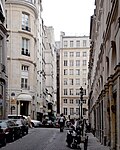Cabinet des Médailles

The Cabinet des Médailles, more formally known as Département des Monnaies, Médailles et Antiques de la Bibliothèque nationale de France, is a department of the Bibliothèque nationale de France in Paris. The Cabinet des Médailles is located in the Richelieu-Louvois building – the former main building of the library – on the Rue de Richelieu. The Cabinet des Médailles is a museum containing internationally important collections of coins, engraved gems, and antiquities, with its distant origins in the treasuries of the French kings of the Middle Ages. The disruptions of the Wars of Religion inspired Charles IX (1560-1574) to create the position of a garde particulier des médailles et antiques du roi ("Special guardian of the King's medals and antiques"). Thus the collection, which has been augmented and never again dispersed, passed from being the personal collection of the king to becoming a national property – a bien national – as the royal collection was declared during the Revolution. A stage in this aspect of its development was the bequest of the collection of pioneering archeologist comte de Caylus, who knew that in this fashion his antiquities would be most accessible to scholars. Other collectors followed suit: when the duc de Luynes gave his collection of Greek coins to the Cabinet Impérial in 1862, it was a national collection rather than simply an Imperial one he was enriching. The State also added to the treasury contained in the Cabinet des Médailles: a notable addition, in 1846, was the early sixth century gold Treasure of Gourdon. The cabinet, in the sense of a small private room for the conservation and display of intimate works of art and for private conversations, rather than a piece of furniture, took a stable shape under Henry IV, who nominated the connoisseur Rascas de Bagarris garde particulier des médailles et antiques du roi, the "particular guardian of the medals and antiquities of the King". Among the antiquarians and scholars who have had the charge of the Cabinet des Médailles, one of the most outstanding was Théophile Marion Dumersan, who began working there in 1795 at the age of sixteen, protected the collection from dispersal by the allies after Napoleon's defeat, and published at his own expense a history of the collection and description, as newly rearranged according to historical principles, in 1838Earlier printed catalogues of parts of the collection had been published. Pierre-Jean Mariette, urged by the comte de Caylus, published a selection of the royal carved hardstones as volume II of hisTraité des pierres gravées.Louis XIV of France, an acquisitive connoisseur, brought together the cabinet of curiosities of his uncle Gaston d'Orléans and acquired that of Hippolyte de Béthune, the nephew of Henri IV's minister Sully. In order to keep the collections closer at hand, he removed them from the old royal library in Paris to the Palace of Versailles. When Louis' great-grandson Louis XV had attained majority, the Cabinet was returned to Paris in 1724, to take up its present space in the royal library that was designed under the direction of Jules-Robert de Cotte, the son of Mansart's successor at the Bâtiments du Roi. In the Cabinet des Médailles, the medal-cabinet delivered in 1739 by the ébéniste du roi Antoine Gaudreau figures among the greatest pieces of French furniture. Other medal cabinets were delivered for Louis XIV by André-Charles Boulle. The cabinet also still houses its paintings by Boucher, Natoire and Van Loo. Following the French Revolution, a number of precious objects previously kept at the Treasury of Saint-Denis joined the collection of the Cabinet. The Cabinet des Médailles is considered the oldest museum in France. It is located in the former building of the Bibliothèque Nationale, 58 rue Richelieu, Paris I, and can be visited for free every afternoon (13:00-17:00), seven days a week.
Excerpt from the Wikipedia article Cabinet des Médailles (License: CC BY-SA 3.0, Authors, Images).Cabinet des Médailles
Rue Colbert, Paris 2nd Arrondissement (Paris)
Geographical coordinates (GPS) Address Nearby Places Show on map
Geographical coordinates (GPS)
| Latitude | Longitude |
|---|---|
| N 48.8678 ° | E 2.3384 ° |
Address
Bibliothèque nationale - Cour d'Honneur
Rue Colbert
75002 Paris, 2nd Arrondissement (Paris)
Ile-de-France, France
Open on Google Maps











